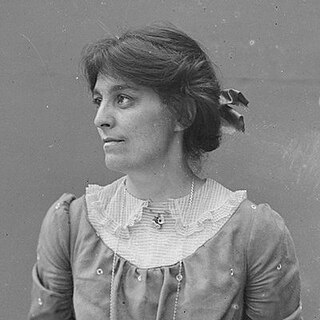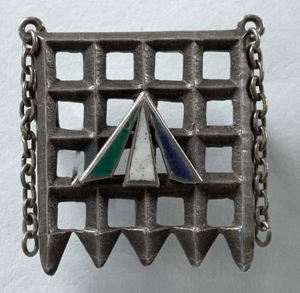
Emmeline Pankhurst was a British political activist who organised the UK suffragette movement and helped women win the right to vote. In 1999, Time named her as one of the 100 Most Important People of the 20th Century, stating that "she shaped an idea of objects for our time" and "shook society into a new pattern from which there could be no going back". She was widely criticised for her militant tactics, and historians disagree about their effectiveness, but her work is recognised as a crucial element in achieving women's suffrage in the United Kingdom.

Estelle Sylvia Pankhurst was a campaigning English feminist and socialist. Committed to organising working-class women in London's East End, and unwilling in 1914 to enter into a wartime political truce with the government, she broke with the suffragette leadership of her mother and sister, Emmeline and Christabel Pankhurst. She was inspired by the Russian Revolution and consulted Lenin, but defied Moscow in endorsing a syndicalist programme of workers' control and by criticising the emerging Soviet dictatorship.

Dame Christabel Harriette Pankhurst, was a British suffragette born in Manchester, England. A co-founder of the Women's Social and Political Union (WSPU), she directed its militant actions from exile in France from 1912 to 1913. In 1914, she supported the war against Germany. After the war, she moved to the United States, where she worked as an evangelist for the Second Adventist movement.

Richard Marsden Pankhurst was an English barrister and socialist who was a strong supporter of women's rights.

The Women's Social and Political Union (WSPU) was a women-only political movement and leading militant organisation campaigning for women's suffrage in the United Kingdom from 1903 to 1918. Known from 1906 as the suffragettes, its membership and policies were tightly controlled by Emmeline Pankhurst and her daughters Christabel and Sylvia; Sylvia was eventually expelled.

Adela Constantia Mary Walsh was a British born suffragette who worked as a political organiser for the WSPU in Scotland. In 1914 she moved to Australia where she continued her activism and was co-founder of both the Communist Party of Australia and the Australia First Movement.

Egginton – or Eggington as it is now known – is a village and civil parish in the Central Bedfordshire district of Bedfordshire, England, about three miles east of Leighton Buzzard.

Emmeline Pethick-Lawrence, Baroness Pethick-Lawrence was a British women's rights activist and suffragette.

A movement to fight for women's right to vote in the United Kingdom finally succeeded through acts of Parliament in 1918 and 1928. It became a national movement in the Victorian era. Women were not explicitly banned from voting in Great Britain until the Reform Act 1832 and the Municipal Corporations Act 1835. In 1872 the fight for women's suffrage became a national movement with the formation of the National Society for Women's Suffrage and later the more influential National Union of Women's Suffrage Societies (NUWSS). As well as in England, women's suffrage movements in Wales, Scotland and other parts of the United Kingdom gained momentum. The movements shifted sentiments in favour of woman suffrage by 1906. It was at this point that the militant campaign began with the formation of the Women's Social and Political Union (WSPU).

A suffragette was a member of an activist women's organisation in the early 20th century who, under the banner "Votes for Women", fought for the right to vote in public elections in the United Kingdom. The term refers in particular to members of the British Women's Social and Political Union (WSPU), a women-only movement founded in 1903 by Emmeline Pankhurst, which engaged in direct action and civil disobedience. In 1906, a reporter writing in the Daily Mail coined the term suffragette for the WSPU, derived from suffragist, in order to belittle the women advocating women's suffrage. The militants embraced the new name, even adopting it for use as the title of the newspaper published by the WSPU.

Mary Jane Clarke was a British suffragette. She died on Christmas Day 1910, two days after being released from prison, where she had been force-fed. She was described in her obituary by Emmeline Pethick-Lawrence as the suffragettes’ first martyr. She was the younger sister of suffragette Emmeline Pankhurst.

The Emmeline and Christabel Pankhurst Memorial is a memorial in London to Emmeline Pankhurst and her daughter Christabel, two of the foremost British suffragettes. It stands at the entrance to Victoria Tower Gardens, south of Victoria Tower at the southwest corner of the Palace of Westminster. Its main feature is a bronze statue of Emmeline Pankhurst by Arthur George Walker, unveiled in 1930. In 1958 the statue was relocated to its current site and the bronze reliefs commemorating Christabel Pankhurst were added.

Mary Elizabeth Phillips was an English suffragette, feminist and socialist. She was the longest prison serving suffragette. She worked for Christabel Pankhurst but was sacked; she then worked for Sylvia Pankhurst as Mary Pederson or Mary Paterson. In later life she supported women's and children's organisations.

Mabel Kate Tuke born Mabel Kate Lear was a British suffragette known for her role of honorary secretary of the militant Women's Social and Political Union.

Gladice Georgina Keevil was a British suffragette who served as head of the Midlands office of the Women's Social and Political Union between 1908 and 1910.

Lillian Dove-Willcox (1875–1963) was a British suffragette who was a member of Emmeline Pankhurst's personal bodyguard.
Caroline Phillips was a Scottish feminist, suffragette and journalist. She was honorary secretary of the Aberdeen branch of the Women's Social and Political Union (WSPU), met and corresponded with many of the leaders of the movement and was also involved in the organisation of militant action in Aberdeen.
Sylvia is a British musical with book by Kate Prince and Priya Parmer, with music by Josh Cohen and DJ Walde and lyrics by Prince based on the life of Sylvia Pankhurst.

The Holloway brooch was presented by the Women's Social and Political Union (WPSU) to women who had been imprisoned at Holloway Prison for militant suffragette activity. It is also referred to as the "Portcullis badge", the "Holloway Prison brooch" and the "Victoria Cross of the Union".

Theodora Ellen Bonwick was a British headteacher, trade unionist, educationist and suffragette.






















